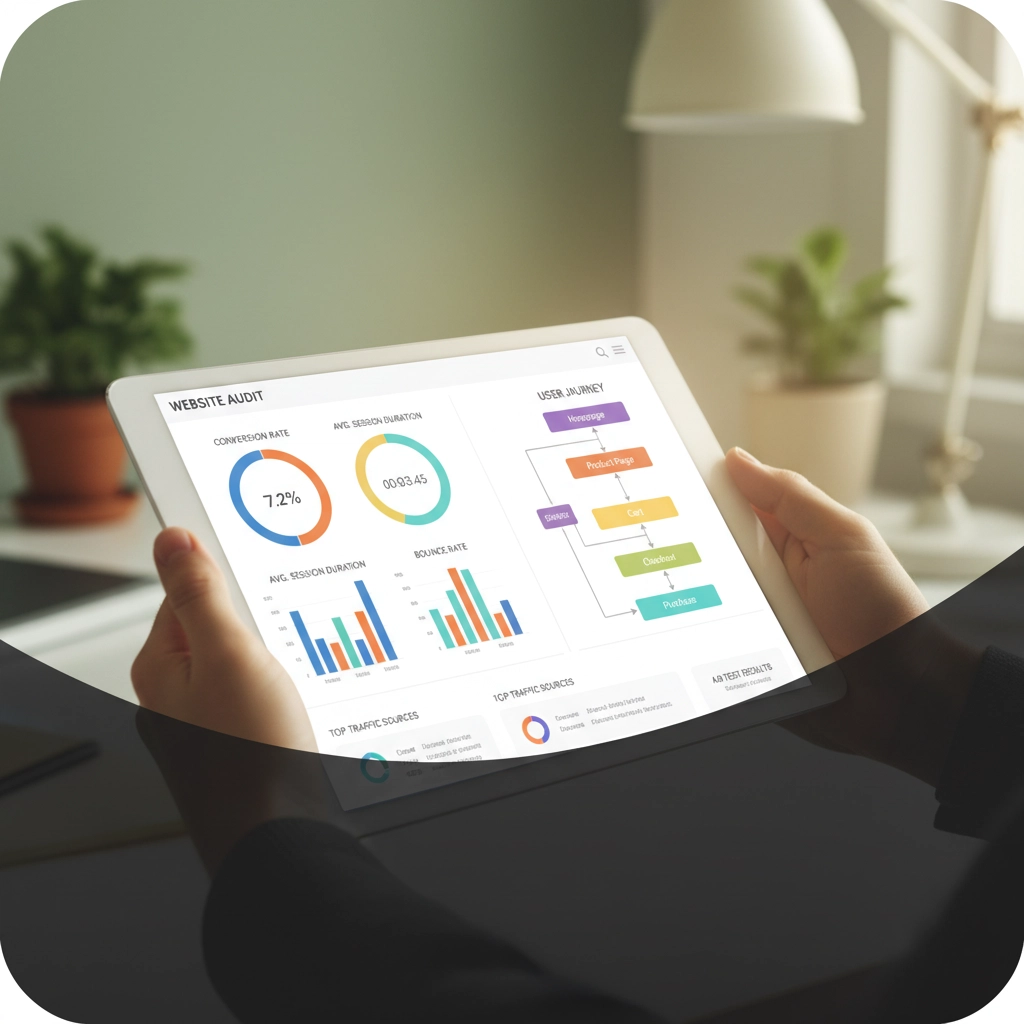Quick Summary: The Main Signs Your Website Isn’t Converting
Your website might be bleeding sales if visitors bounce within seconds, your mobile experience is clunky, or people can’t figure out what you actually do. The biggest culprits are slow loading times, weak calls-to-action, unclear branding, and missing lead capture systems. The fix isn’t just about tweaking one thing: it’s about getting your design, messaging, technical performance, and user journey working together as a complete sales system.
Your Website Should Work Like a Silent Salesperson
Most business owners think their website is just an online brochure. That’s the first mistake. Your website should be converting visitors into leads and customers 24/7, but instead, it might be quietly turning them away.
The problem is that everything has to work together. Great design means nothing if your site loads slowly. Perfect branding falls flat if your calls-to-action are buried. Fast loading times won’t save you if visitors can’t understand what you offer.
Warning Signs Your Website Is Costing You Sales
Visitors Leave Before They Even See Your Content
If your website takes more than 3 seconds to load, you’re losing potential customers before they see a single word. They’re not being patient: they’re clicking back and visiting your competitor’s faster site instead.
This isn’t just about technical performance. A slow website signals to visitors that your business might be outdated or unprofessional. That split-second judgement affects everything that comes after.
Your Mobile Experience Drives People Away
When someone visits your site on their phone, can they easily read your text, click your buttons, and navigate to what they need? If your mobile experience is clunky, you’re losing more than half your potential traffic.
Most business owners still design for desktop first, then hope mobile “works okay.” That’s backwards. Your mobile experience should be seamless, with your main call-to-action appearing immediately and your contact information easy to find.

Nobody Knows What You Actually Do
Stand back and look at your homepage with fresh eyes. Within 5 seconds, can a stranger understand exactly what you offer and why they should choose you? If your value proposition isn’t crystal clear, visitors will leave to find someone who explains their services better.
This often happens when business owners try to be clever with their messaging instead of clear. Your website copy should answer three questions immediately: What do you do? How does it help me? What should I do next?
Your Branding Looks Like Everyone Else’s
Generic stock photos, template designs, and cookie-cutter logos don’t build trust. They make you look like every other business in your industry. When visitors can’t distinguish you from your competitors, they’ll usually go with whoever they’ve heard of before.
Strong branding isn’t about being flashy: it’s about being memorable and trustworthy. Your visual identity should support your message, not compete with it.
How to Diagnose What’s Actually Wrong
Start With a Proper Website Audit
Most business owners guess at what’s wrong with their website instead of looking at real data. A comprehensive website audit reveals exactly where visitors are getting stuck and why they’re leaving.
Look at your bounce rate first. If more than 70% of visitors leave immediately, you have a fundamental problem with either your messaging, loading speed, or user experience. Your conversion rate tells the complete story: if less than 2-3% of visitors take any meaningful action, your website isn’t fulfilling its primary job.
Track the Right Metrics
Page views don’t matter if nobody’s buying anything. Focus on metrics that actually relate to sales: how many visitors fill out your contact form, how many download your resources, how many make it to your service pages.
Cart abandonment rate matters for e-commerce, but service businesses should track form abandonment rates. If people start filling out your contact form but don’t finish, your form might be too long or asking for too much information too early.
Understand Your User Journey
Map out exactly how someone should move through your website from first visit to becoming a customer. Most websites send visitors in circles instead of guiding them towards a specific next step.
Every page should have a clear purpose and a logical next action. Your homepage should funnel people to your service pages. Your service pages should lead to contact forms or consultation bookings. Your blog posts should connect to relevant services.

Solutions That Actually Move the Needle
Fix Your Technical Foundation First
Your website’s technical performance affects everything else. Slow loading speeds kill conversions before visitors see your brilliant copy or beautiful design. Optimise your images, clean up unnecessary plugins, and make sure your hosting can handle your traffic.
But technical fixes are just the foundation. You also need the right content management system, proper SEO structure, and mobile optimisation. These elements work together to make sure people can find you and have a smooth experience when they do.
Redesign With Conversion in Mind
Sometimes your website needs more than tweaks: it needs a complete redesign that puts conversion at the centre of every decision. This isn’t about making things prettier; it’s about creating a user experience that naturally guides visitors towards becoming customers.
A conversion-focused redesign considers how people actually browse websites. They scan rather than read. They judge credibility within seconds. They want to find what they need without thinking about navigation. Every element should support these natural behaviours.
Get Your Messaging Right
Clear, compelling copy transforms websites from digital brochures into sales tools. Your messaging should speak directly to your ideal customer’s problems and present your services as the logical solution.
This often requires a complete content strategy overhaul. Your homepage copy, service descriptions, and about page should work together to build a case for choosing your business. Each piece of content should move visitors closer to contacting you.
Create a Visual Identity That Builds Trust
Professional logo design and cohesive branding make everything else work better. When your visual identity looks polished and consistent, visitors spend less mental energy deciding whether to trust you and more energy engaging with your content.
Your branding should extend beyond just colours and fonts. It should influence your photography style, the tone of your copy, and even how you structure your content. Everything should feel like it comes from the same professional business.

How Everything Works Together
Integration Is Everything
Great websites aren’t built from isolated pieces: they’re integrated systems where each element amplifies the others. Your SEO strategy should support your conversion goals. Your social media should drive traffic to optimised landing pages. Your email automation should nurture the leads your website captures.
This is where many DIY efforts fall apart. Business owners optimise one thing at a time instead of creating a cohesive system. They improve their loading speed but ignore their calls-to-action. They invest in beautiful design but skip conversion optimisation.
Content That Converts
Your blog shouldn’t just showcase your expertise: it should funnel readers towards your services. Every article should connect to relevant service pages and include clear next steps for engaged readers.
Video content is particularly effective at building trust and explaining complex services. Short explainer videos can communicate in 60 seconds what might take paragraphs of text. The key is integration: your video content should support your overall conversion strategy, not exist in isolation.
Lead Capture and Nurturing Systems
Most website visitors aren’t ready to buy on their first visit, but many are interested enough to exchange their contact information for something valuable. This requires both strategic thinking about what to offer and marketing automation to nurture those leads over time.
Your lead magnets should relate directly to your services and attract your ideal customers. A law firm might offer a legal checklist. A web design agency might provide a website audit template. The goal is starting conversations with qualified prospects.
Taking Action: Your Next Steps
Don’t try to fix everything at once. Start with the biggest problems first: if your site loads slowly, fix that before worrying about your logo. If people can’t understand what you do, clarify your messaging before tweaking your design.
Most business owners know their website could be better, but they don’t know where to start or how everything fits together. The most successful approach combines technical expertise, design thinking, and marketing strategy into one cohesive plan.
Your website should be your best salesperson, working around the clock to convert visitors into customers. When all the pieces work together: fast loading, clear messaging, professional design, strategic user experience, and effective lead capture: your website becomes a business asset that actually drives growth instead of just looking professional.
The difference between a website that costs you sales and one that drives them isn’t just one thing. It’s how everything works together to create an experience that builds trust, provides value, and makes taking the next step feel natural and obvious.
Move your website or brand in the right direction
Book a call or contact the Kefilab team for tailored guidance. Whether you need a website audit, a full redesign, or just want expert advice on the next step, you’ll get a clear, actionable plan.
- Website audit that prioritises fixes and opportunities
- Conversion-led full redesign that turns visits into leads
- Expert advice on your smartest next step
Book a call or contact the team.

